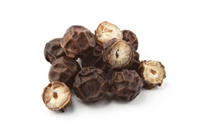Black Pepper
Black Pepper
Pronounced: pep·ər

Black Pepper (Piper nigrum) is a flower-producing vine in the Piperaceae family and is harvested for use as a seasoning, spice, or health supplement. Black pepper falls under the category of spices and condiments on most restaurant supply sites. The eastern part of the world celebrates this dried fruit of the tree Piperaceae, as the King of Spices. When dried, the fruit is referred to as a peppercorn and contains a single seed. When fully mature it is a deep shade of red and measures about 0.20 inches. The black powdery form of pepper with which most individuals are familiar is derived from grinding mature peppercorns until they reach a fine texture.
Black pepper is extensively harvested in India where it is found in abundance. Pepper grows best in warm climates and tropical regions and Vietnam is currently the world’s largest exporter of pepper.
What Is Black Pepper?
 Black pepper is derived from the fruit of a climbing vine native to southern India and Sri Lanka. Pepper comes from several species of a vinous plant, the spice being the fruit, called peppercorns. Black pepper is the dried, unripe berry. The corns are wrinkled and spherical, about 5 mm (1/8 in) in diameter. Malabar and Tellicherry pepper are both considered top quality due to size and maturity, with only 10% of the largest corns being graded as Tellicherry.
Black pepper is derived from the fruit of a climbing vine native to southern India and Sri Lanka. Pepper comes from several species of a vinous plant, the spice being the fruit, called peppercorns. Black pepper is the dried, unripe berry. The corns are wrinkled and spherical, about 5 mm (1/8 in) in diameter. Malabar and Tellicherry pepper are both considered top quality due to size and maturity, with only 10% of the largest corns being graded as Tellicherry.
Black Pepper is used almost universally, black pepper is one of the most common condiments worldwide and figures prominently in most curry recipes. It is also frequently included in the prescriptions of Ayurvedic and other traditional health practitioners. The spicy tang of black pepper is due to its most important and well-researched phytochemical, piperine.
Thanks to many of its constituent compounds such as eugenol, kaempferol, myrcene, quercetin and rutin black pepper is a much more effective antioxidant than many fruit and vegetables. Moreover it contains the unique compound, piperine, that is capable of enhancing the bioavailability of important nutritive compounds in other foods and spices.
Plant and Cultivation
Typically pepper orchard consist of a small plot of land where moisture and shade were abundant. The pepper vines would be planted next to tall trees in order to be able to train the vine’s growth pattern. The idea was to get the plant to grow upwards, allowing full berry production.
Pepper plants are planted at the beginning of the monsoon season. The plants would shoot up and start to climb the taller surrounding trees. Since the berries are fragile, picking the fruit was done with great care. After picking, the pepper berries they are spread out onto the ground and allowed to dry until they turned black and shriveled up. After about a month’s storage, they are ready to be sold as black peppercorns.
Description
Black pepper is undoubtedly the most popular and important spice in the world. Pepper is a very pungent spice, and gets this from a volatile oil called alkaloid piperine. The pepper plant itself is a perennial vine that has dark green leaves and small white flowers. These flowers become clusters of green berries, which is the product known as green peppercorns. Black peppercorns are the unripe berries that have been sun-dried, while white peppercorns are just black peppercorns with their outer skins rubbed off.
Black peppercorns are harvested as the berries are turning red, just before they are completely ripe. They are left on mats to dry and ferment in the sun. This must be done quickly to prevent mold. As the berries dry they turn black in color. Because the pungency of black peppercorns comes mostly from the outer, black cover, they are stronger than the white peppercorns.
Producing Countries of Black Pepper
Over the last 20 years black pepper exports have increased from 76,816 tons to 197,447 tons recording an annual growth rate of 5%. Today, Vietnam is actually the world’s largest producer and exporter of pepper, accounting for 34%, while India now provides 19% of this spice. It’s interesting to think that pepper was once currency and now pepper and pepper grinders are items found in just about every home.
Consuming Countries of Black Pepper
United States is the number one importer of pepper in the world. United States imported more pepper than any one country exported. United States bought a total of 18% of the world’s pepper in 2009. The next largest buyer of pepper was Germany, who bought less than half that of the United States.
